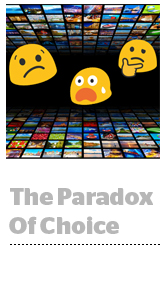
Streamers don’t browse – at least not on streaming services.
Although the majority of households either own a smart TV and/or have a subscription-video-on-demand service (SVOD), most people (58%) still gravitate back to traditional TV channels when they’re not sure what they want to watch, according to Nielsen’s total audience report for Q1, released Monday.
VOD subscribers generally stream with purpose. Sixty-six percent of adults 18 and older know exactly what they’re looking for when they use a streaming service. Only one-third of US adults browse their SVOD content menus.
The findings are in line with the conundrum of our times (and the ultimate first-world problem): We’re living in the golden age of content … and there’s nothing to watch.
Out of frustration, people turn to linear channel surfing and browsing their DVR recordings.
Problem is, the group most susceptible to bouts of content indecision is the group marketers are most ardently looking to reach: 18- to 49-year-olds.
Although younger consumers between 18 and 34 years old are more apt to explore streaming content without a clear idea in mind – 45% will browse the menu on their subscription service compared with 34% of 35- to 49-year-olds – 52% still turn back to their favorite linear TV channels when they want to watch something, but they’re just not sure what.
All this indecision isn’t the consumer’s fault; it’s the paradox of choice. There’s just a lot of content out there to sift through.
But that’s also an opportunity for SVOD content creators, programmers and marketers to do a better job at helping viewers either find what they’re looking for or to make a selection even if they don’t have something specific in mind when they arrive.
Too much choice leads to no choice at all, said Peter Katsingris, SVP of audience insights at Nielsen.
“The challenge for media owners is to get their content or promotion of content to stand out and be sticky as a way to reel in eyeballs,” he said.
If they can refine the ways they reach consumers and showcase their content, it could “help drive viewing, as well as create a fertile environment for marketers to capitalize on that consumer attention,” Katsingris said.
It’s up to media owners and marketers to disrupt the “heavily ingrained and habitual nature of the viewing experience,” he said, which “can only be done with menu algorithms that work perfectly, every time, time and again.”
Despite content discovery headaches, Nielsen found that US adults are spending more time than ever – 11 hours and 27 minutes a day – interacting with media across channels, including linear, connected TV, mobile, desktop and radio. That’s up 21 minutes since the first quarter of last year.
This post was syndicated from Ad Exchanger.


More Stories
Stuff Group brings new leader for North Island on board
Telemundo Arizona Names Evening Co-Anchors
TBWA\ New Zealand event provides insights into the future of sport